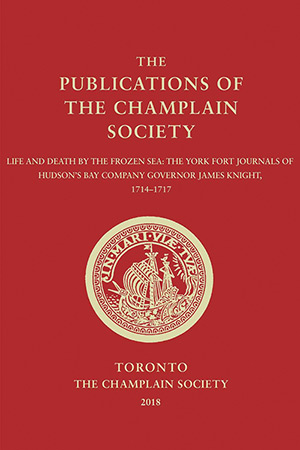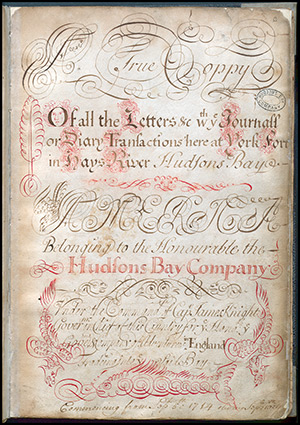by Michael Payne
Ottawa, Ontario
|
Arthur J. Ray (ed.), Life and Death by the Frozen Sea: The York Fort Journals of Hudson’s Bay Company Governor James Knight, 1714-1717. Toronto: Champlain Society, 2018, volume 79, 509 pages. ISBN 978-1-4875-0472-4, $94.29 (hardcover)
 Since its foundation in 1905 the Champlain Society has published over 100 edited collections of documentary records in Canadian history. Not only has the society been remarkably prolific as a publisher, these volumes have collectively reshaped our understanding of Canadian history. Fur trade history has been particularly graced in this regard, and no researcher with an interest in Hudson’s Bay Company, North West Company, Indigenous, or early northern or western Canadian history has not been influenced by the work of E. E. Rich, J. B. Tyrrell, Richard Glover, Irene Spry, W. L. Morton, and H. P. Biggar—among many others—as volume editors. Interestingly, in many cases their work as editors of these collections of primary documents retains interest and historiographical significance long after their more conventional historical monographs have lost some of their academic currency and favour. This is not to suggest that the other work of Arthur Ray is about to be superseded any time soon, but publications of edited versions of primary source materials such as those undertaken by the Champlain Society fill an important, and still very relevant, niche in historical research and writing.
Since its foundation in 1905 the Champlain Society has published over 100 edited collections of documentary records in Canadian history. Not only has the society been remarkably prolific as a publisher, these volumes have collectively reshaped our understanding of Canadian history. Fur trade history has been particularly graced in this regard, and no researcher with an interest in Hudson’s Bay Company, North West Company, Indigenous, or early northern or western Canadian history has not been influenced by the work of E. E. Rich, J. B. Tyrrell, Richard Glover, Irene Spry, W. L. Morton, and H. P. Biggar—among many others—as volume editors. Interestingly, in many cases their work as editors of these collections of primary documents retains interest and historiographical significance long after their more conventional historical monographs have lost some of their academic currency and favour. This is not to suggest that the other work of Arthur Ray is about to be superseded any time soon, but publications of edited versions of primary source materials such as those undertaken by the Champlain Society fill an important, and still very relevant, niche in historical research and writing.
Our fascination with these publications lies partly in the fact that they resemble a kind of historiographical cutaway drawing. As readers we get to see the raw archival material that historians and editors work with, and also share their research notes as they determine what a cryptic and archaic term like “pissburn’d fox,” for example, means (p. 106) or what an apparent reference in 1715 to the Athabasca oil sands (p. 145) may signify. In this case, Ray helpfully lets us know the pissburn’d fox in question is almost certainly a cross fox, thus saving readers an internet or library search of 18th century slang, and the reference to bitumen deposits speaks to the Hudson’s Bay Company’s and James Knight’s commercial interest in expanding trade beyond furs. But more than just aiding readers with this sort of contextual insight, the introduction and editorial notes included with these publications of archival materials reveal how each historian/editor fashions primary research materials into a coherent historical narrative and analysis. As a reader you get to see both the raw stuff of historical research and the significance that a careful and experienced historian makes of that data.
 |
The cover of James Knight’s journal from York Fort, 1714. |
In choosing James Knight’s York Fort journals for the period of 1714–1717, Ray has outstanding material to work with. To begin with, the journals cover one of the most important and dramatic periods in the early history of the fur trade on western Hudson Bay. After assisting the London Committee of the Hudson’s Bay Company secure control over its bayside posts under the Treaty of Utrecht, Knight was sent to York Fort (later York Factory) to take possession of what would become, for a century and a half, the most important of the Hudson’s Bay Company’s trading posts. He inherited a post in ruins and a trade in disarray, and these journals detail how he rebuilt the post, despite flooding and a lack of trade goods and building materials, and re-established a stable, secure, and generally profitable trade at York. This trade was conducted not just with the nearby Cree of the Hudson Bay lowlands, but also with Indigenous peoples across a huge hinterland that extended as far inland as the Lake Athabasca area and even the eastern slopes of the Rockies. It was during Knight’s tenure at York that Thanadelthur was sent inland with a party of local Cree and William Stuart to negotiate a peace agreement with Athapaskan groups that would allow Athapaskan bands to travel to York (and later Churchill) to trade. The story of Thanadelthur’s courage and perseverance remains one of the best evidences of the crucial role women played in the fur trade, and it is in these journals that her diplomatic triumph is revealed. The long-distance trade that Chipewyan middleman traders developed after her peace initiative would remain a key part of the success of York and Churchill as trade centers until the late 18th century.
This trade initiative also reflects Knight’s belief that the corporate interests of the Hudson’s Bay Company were best served by keeping its posts along the shores of Hudson and James Bays and not building interior posts. This meant that the costs and dangers associated with transporting furs from inland to bayside posts were borne by Indigenous middleman traders, who in turn profited by exchanging European trade goods with inland peoples at very steep markups. Knight’s policy was perhaps conservative and passive, at least in some critics’ views, but it also helped ensure that the Company operated profitably for most of the 18th century. It was also a reflection of the fact that most of the Indigenous groups living near Hudson and James Bays had little interest in or willingness to support direct trade with their inland neighbours, and, as Knight knew, they would have actively opposed such a policy at the time.
Knight’s fascination with trade strategy and the practical issues of operating a large post on the shores of Hudson Bay meant he put extraordinary effort into seeking out information about the geography and resources of the home territories of the various Indigenous peoples that came to York to trade. This makes his journal entries a treasure trove of detailed information on geography, ethnography, natural history, and day-to-day post operations. Most researchers who have spent any time using Hudson’s Bay Company archival records have encountered post journals that consist of entry after entry consisting of a perfunctory weather report and the notation: “men employed as yesterday.” Not so with Knight’s journals, which Ray notes are “extraordinary,” “voluminous,” as well as “influential, complicated, and informative” (p. xiv).
The journals conclude with a story of tragedy and mystery. As part of his agreement to work for the Hudson’s Bay Company, Knight was entitled to a payment of one-tenth of any profits made from any minerals he discovered. His discussions with inland trading groups often focused on whether or not copper, gold, or other minerals might be found in their territories, and Knight believed that he knew how to reach the Coppermine River by sea. He did not, of course, although his Indigenous informants actually gave him a reasonably accurate account of their overland route to the Coppermine and Mackenzie Rivers. But getting there by sea was a very different proposition. Knight also believed that their accounts of a forested region along the Mackenzie River must have meant that they had turned south again, and had perhaps reached the mythical Strait of Anian, that most geographers of the time believed was connected to the Pacific Ocean. Knight’s misinterpretation of the information he received led him to invest in 1719, with the Hudson’s Bay Company, in an expedition that would try to reach the copper mines on the Coppermine River by sea. Knight sailed off to find his fortune (despite being almost 80 years old) and soon after disappeared with two ships and all of his men into the largely uncharted waters of northern Hudson Bay. It was later determined that he and his men were forced to winter on Marble Island, between Rankin and Chesterfield Inlet, and that the entire party perished there. The story forms a sad, and still somewhat mysterious epilogue to this publication, but it also is a reminder of just how wide-ranging James Knight’s interests were and how actively he pursued them.
Since 1905 the publications of the Champlain Society have set an exacting standard of editorial excellence and thoughtful selection of primary materials to publish in book form. This particular volume is a more than worthy addition to that tradition. Arthur Ray’s introduction and notes are thorough, engaging, and balanced. Knight’s journals are a revelation for anyone who has not encountered them before, and readers will quickly comprehend just how great a debt modern historians owe to his keen observations and deep curiosity about the country around Hudson Bay.
We thank Clara Bachmann for assistance in preparing the online version of this article.
We thank S. Goldsborough for assistance in preparing the online version of this article.
Page revised: 25 April 2021